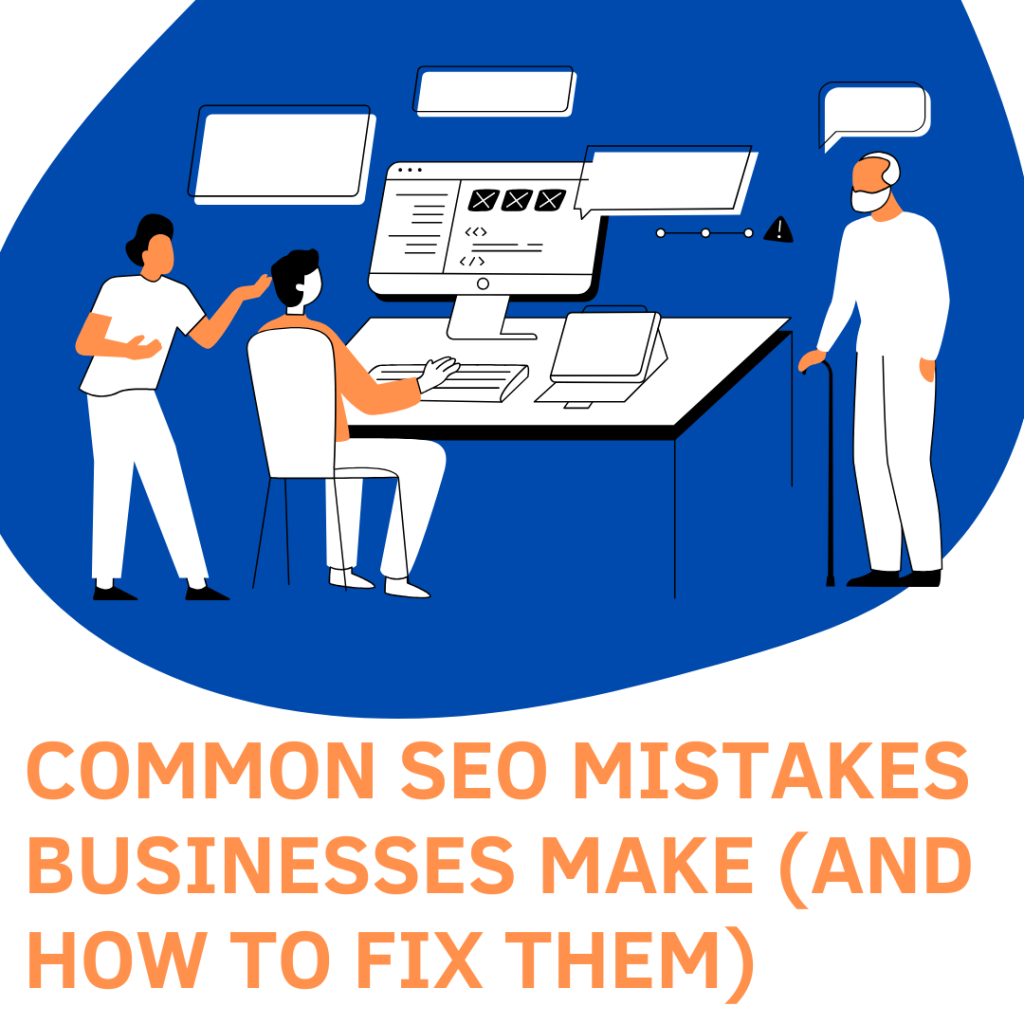
Search engine optimization (SEO) is essential for increasing online visibility and driving organic traffic. Many businesses, however, make critical mistakes that lower their search rankings and limit their online reach. By understanding these common SEO mistakes and learning how to fix them, businesses can improve their search engine performance and attract more customers.
1. Ignoring Keyword Research
Mistake
Many businesses create content without proper keyword research. They either guess which keywords to target or use generic ones that do not match user intent. This results in poor search rankings and reduced visibility.
How to fix
Use keyword research tools such as Google Keyword Planner, Ahrefs, or SEMrush to find relevant keywords with high search volume and low competition. Focus on a mix of short-tail and long-tail keywords. Short-tail keywords are broad (e.g., “digital marketing”), while long-tail keywords are more specific (e.g., “digital marketing tips for small businesses”).
Ensure keywords fit naturally within the content, including titles, headers, meta descriptions, and body text. Avoid overloading content with keywords, as this can hurt readability and lead to penalties.
2. Using Duplicate Content
Mistake
Publishing duplicate content, whether copied from another website or repeated across multiple pages, confuses search engines. Google may penalize websites with duplicate content, resulting in lower rankings.
How to Fix
Create unique and original content for every page. Use plagiarism-checking tools like Copyscape or Grammarly to ensure content uniqueness. If similar content must exist across pages, use canonical tags to tell search engines which version to prioritize.
Additionally, avoid using auto-generated content, as search engines value high-quality, human-written content that provides genuine value.
3. Neglecting Mobile Optimization
Mistake
A website that does not function well on mobile devices frustrates users and ranks lower in search results. With most internet searches happening on mobile devices, mobile optimization is crucial.
How to fix
Use responsive web design to ensure your website adapts to different screen sizes. Test mobile performance using Google’s Mobile-Friendly Test. Improve page load times by compressing images, enabling lazy loading, and reducing unnecessary scripts. Ensure buttons and navigation are easily clickable on small screens.
4. Ignoring Meta Descriptions and Title Tags
Mistake
Many businesses fail to optimize title tags and meta descriptions, which are essential for click-through rates (CTR). Generic or missing descriptions reduce the chances of users clicking on search results.
How to fix
Write compelling, keyword-rich title tags and meta descriptions for every page. Titles should be under 60 characters, while meta descriptions should be under 160 characters. Keep them clear and action-driven to encourage clicks.
Example:
- Title Tag: “10 Proven SEO Strategies for Small Businesses”
- Meta Description: “Boost your website traffic with these 10 proven SEO strategies. Learn how to improve rankings and attract more customers today!”
5. Slow Website Speed
Mistake
A slow-loading website increases bounce rates and negatively impacts search rankings. Users expect fast-loading pages, and search engines prioritize websites that offer a smooth experience.
How to fix
Compress images without losing quality using tools like TinyPNG or ImageOptim. Enable browser caching and use a content delivery network (CDN) to speed up page loading. Minimize JavaScript and CSS files and reduce unnecessary plugins.
Use Google PageSpeed Insights to analyze and improve loading speed.
6. Not Using Internal Links
Mistake
Many businesses fail to use internal links, making it harder for search engines to understand site structure. This limits content discoverability and reduces ranking potential.
How to fix
Include relevant internal links within your content to connect pages and guide users. Use descriptive anchor text instead of generic phrases like “click here.” Well-structured internal linking improves user navigation and helps search engines index pages more effectively.
7. Poor URL Structure
Mistake
Long, complex URLs with unnecessary characters make it difficult for users and search engines to understand page content.
How to fix
Use short, descriptive URLs with relevant keywords. Avoid numbers, special characters, and excessive parameters. Example:
- Bad URL: www.example.com/p=12345
- Good URL: www.example.com/seo-tips-for-beginners
8. Not Optimizing Images
Mistake
Large image files slow down websites, and missing alt text prevents search engines from understanding image content.
How to fix
Compress images before uploading them. Use descriptive file names and add alt text that accurately describes the image. Alt text improves accessibility and helps images appear in search results.
9. Ignoring Local SEO
Mistake
Businesses that do not optimize for local searches miss out on potential customers in their area.
How to fix
Create and verify a Google My Business profile. Use location-based keywords, add business hours, and encourage customer reviews. Ensure your name, address, and phone number (NAP) remain consistent across all online directories.
10. Not Updating Content Regularly
Mistake
Old, outdated content ranks lower in search results and reduces credibility.
How to fix
Regularly update blog posts, service pages, and product descriptions with new information and relevant keywords. Refresh old content with new insights, statistics, and images to keep it useful and engaging.
11. Overusing Keywords
Mistake
Keyword stuffing makes content hard to read and can lead to search engine penalties.
How to fix
Use keywords naturally throughout content. Prioritize readability over keyword density. Ensure each piece of content is informative, engaging, and valuable to users.
12. Ignoring Backlinks
Mistake
Backlinks from reputable websites boost domain authority, but many businesses do not focus on link-building.
How to fix
Earn backlinks by creating high-quality content, reaching out to industry blogs, and guest posting. Avoid spammy backlinks, as low-quality links can harm rankings.
13. Not Tracking SEO Performance
Mistake
Failing to monitor SEO performance makes it difficult to improve strategies.
How to fix
Use Google Analytics and Google Search Console to track keyword rankings, traffic, and user behavior. Analyze data and adjust SEO efforts accordingly.
Conclusion
Avoiding these SEO mistakes improves search rankings and increases website traffic. Businesses should focus on keyword research, mobile optimization, content freshness, and user experience. Consistent efforts lead to long-term success in search engine visibility.

Article by:
Oyejobi Adeola, founder of NiveDigital & NiveDigital Academy, is a top expert in SEO and digital marketing.
With over a decade of experience, he has helped businesses grow through advanced SEO strategies and trained hundreds of students to succeed online.
His insights have been featured in top industry publications.

